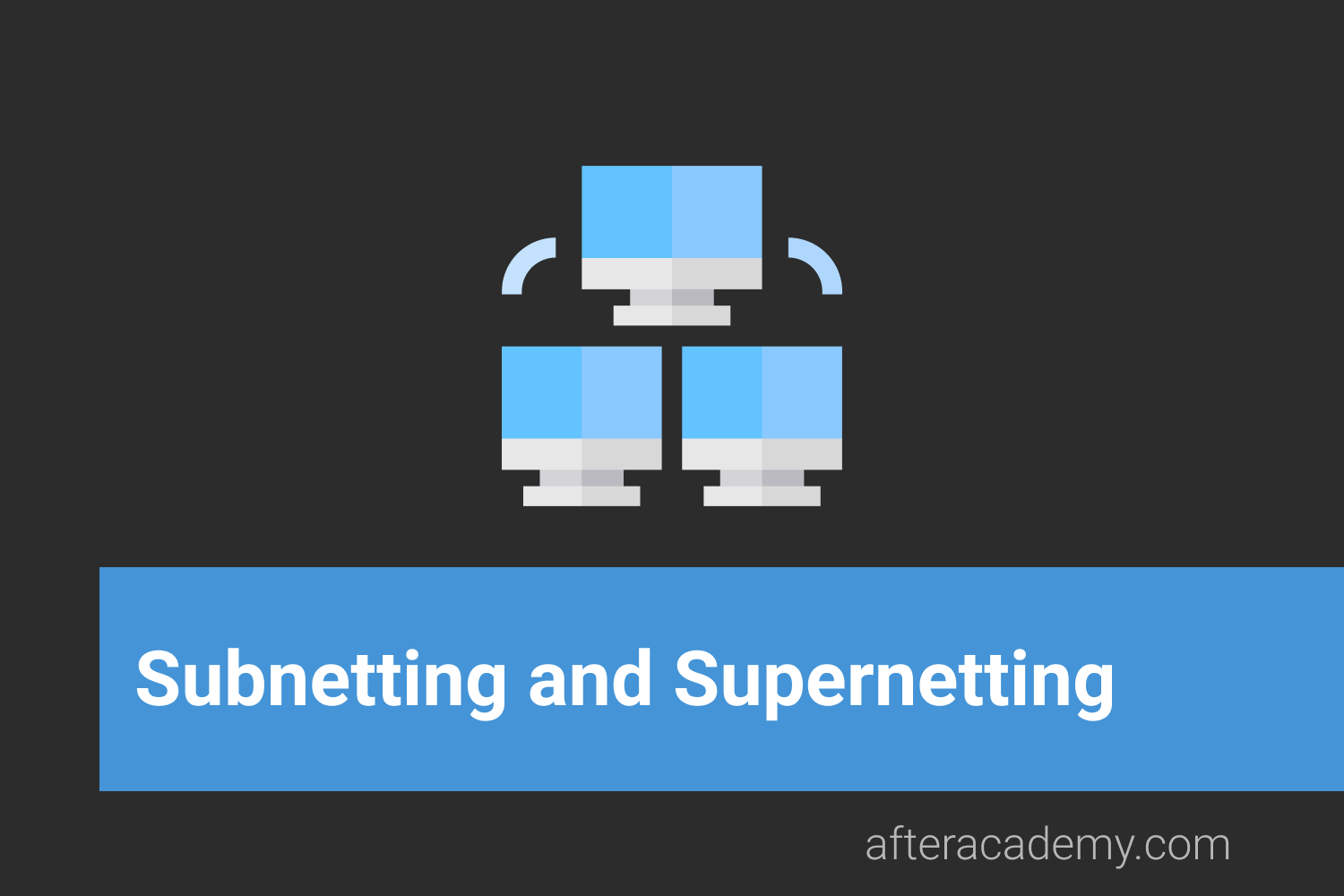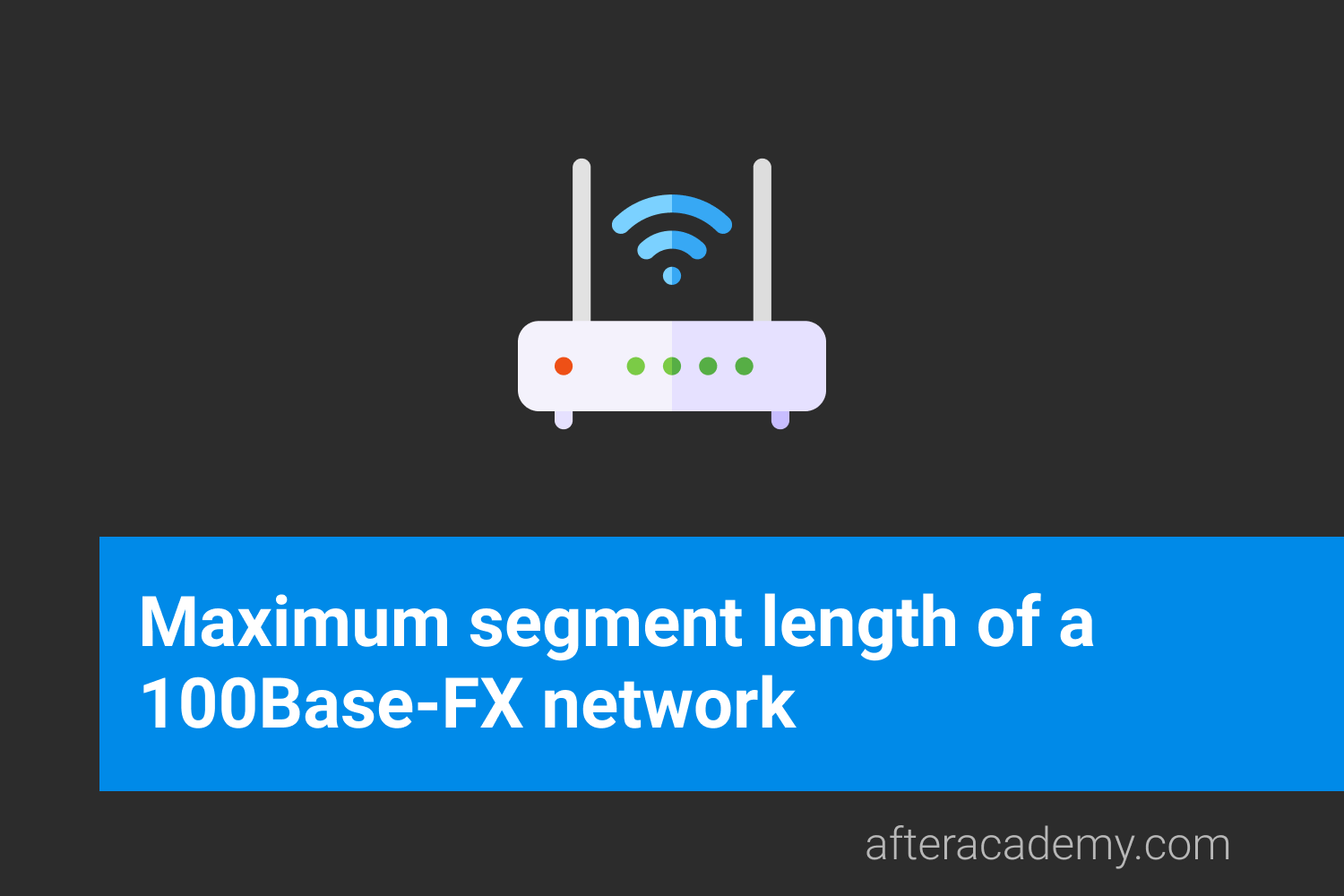What are the Data Transmission Modes in a network?

Data Transmission mode defines the direction of the flow of information between two communication devices . It is also called Data Communication or Directional Mode. It specifies the direction of the flow of information from one place to another in a computer network.
In the Open System Interconnection(OSI) Layer Model, the Physical Layer is dedicated to data transmission in the network. It mainly decides the direction of data in which the data needs to travel to reach the receiver system or node.
So, in this blog, we will learn about different data transmission modes based on the direction of exchange, synchronization between the transmitter and receiver, and the number of bits sent simultaneously in a computer network.
The data transmission modes can be characterized in the following three types based on the direction of exchange of information:
- Simplex
- Half-Duplex
- Full Duplex
The data transmission modes can be characterized in the following two types based on the synchronization between the transmitter and the receiver:
- Synchronous
- Asynchronous
The data transmission modes can be characterized in the following two types based on the number of bits sent simultaneously in the network:
- Serial
- Parallel
Now, let us study these various data transmission modes in the computer network one by one.
According to the Direction of Exchange of Information:
1. Simplex
Simplex is the data transmission mode in which the data can flow only in one direction, i.e., the communication is unidirectional. In this mode, a sender can only send data but can not receive it. Similarly, a receiver can only receive data but can not send it.
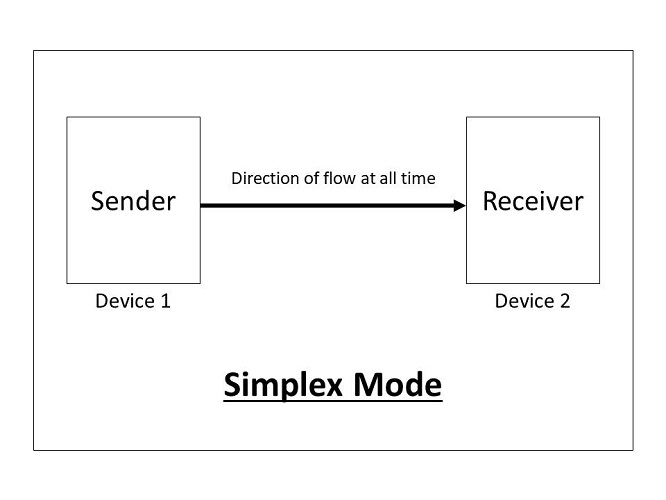
This transmission mode is not so popular because we cannot perform two-way communication between the sender and receiver in this mode. It is mainly used in the business field as in sales that do not require any corresponding reply. It is similar to a one-way street.
For Example, Radio and TV transmission, keyboard, mouse, etc.
Following are the advantages of using a Simplex transmission mode:
- It utilizes the full capacity of the communication channel during data transmission.
- It has the least or no data traffic issues as data flows only in one direction.
Following are the disadvantages of using a Simplex transmission mode:
- It is unidirectional in nature having no inter-communication between devices.
- There is no mechanism for information to be transmitted back to the sender(No mechanism for acknowledgement).
2. Half-Duplex
Half-Duplex is the data transmission mode in which the data can flow in both directions but in one direction at a time. It is also referred to as Semi-Duplex. In other words, each station can both transmit and receive the data but not at the same time. When one device is sending the other can only receive and vice-versa.

In this type of transmission mode, the entire capacity of the channel can be utilized for each direction. Transmission lines can carry data in both directions, but the data can be sent only in one direction at a time.
This type of data transmission mode can be used in cases where there is no need for communication in both directions at the same time. It can be used for error detection when the sender does not send or the receiver does not receive the data properly. In such cases, the data needs to be transmitted again by the receiver.
For Example, Walkie-Talkie, Internet Browsers, etc.
Following are the advantages of using a half-duplex transmission mode:
- It facilitates the optimum use of the communication channel.
- It provides two-way communication.
Following are the disadvantages of using a half-duplex transmission mode:
- The two-way communication can not be established simultaneously at the same time.
- Delay in transmission may occur as only one way communication can be possible at a time.
3. Full-Duplex
Full-Duplex is the data transmission mode in which the data can flow in both directions at the same time. It is bi-directional in nature. It is two-way communication in which both the stations can transmit and receive the data simultaneously.

Full-Duplex mode has double bandwidth as compared to the half-duplex. The capacity of the channel is divided between the two directions of communication. This mode is used when communication in both directions is required simultaneously.
For Example, a Telephone Network, in which both the persons can talk and listen to each other simultaneously.
Following are the advantages of using a full-duplex transmission mode:
- The two-way communication can be carried out simultaneously in both directions.
- It is the fastest mode of communication between devices.
Following are the disadvantages of using a half-duplex transmission mode:
- The capacity of the communication channel is divided into two parts. Also, no dedicated path exists for data transfer.
- It has improper channel bandwidth utilization as there exist two separate paths for two communicating devices.
According to the synchronization between the transmitter and the receiver:
1. Synchronous
The Synchronous transmission mode is a mode of communication in which the bits are sent one after another without any start/stop bits or gaps between them. Actually, both the sender and receiver are paced by the same system clock. In this way, synchronization is achieved.
In a Synchronous mode of data transmission, bytes are transmitted as blocks in a continuous stream of bits. Since there is no start and stop bits in the message block. It is the responsibility of the receiver to group the bits correctly. The receiver counts the bits as they arrive and groups them in eight bits unit. The receiver continuously receives the information at the same rate that the transmitter has sent it. It also listens to the messages even if no bits are transmitted.
In synchronous mode, the bits are sent successively with no separation between each character, so it becomes necessary to insert some synchronization elements with the message, this is called " Character-Level Synchronization ".
For Example, if there are two bytes of data, say(10001101, 11001011) then it will be transmitted in the synchronous mode as follows:
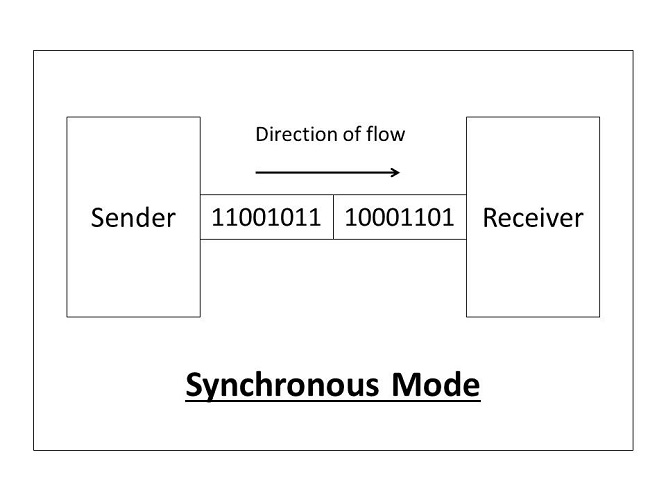
For Example, communication in CPU, RAM, etc.
Following are the advantages of using a Synchronous transmission mode:
- Transmission speed is fast as there is no gap between the data bits.
Following are the disadvantages of using a Synchronous transmission mode:
- It is very expensive.
Parallel
2. Asynchronous
The Asynchronous transmission mode is a mode of communication in which a start and the stop bit is introduced in the message during transmission. The start and stop bits ensure that the data is transmitted correctly from the sender to the receiver.
Generally, the start bit is '0' and the end bit is '1'.Asynchronous here means 'asynchronous at the byte level', but the bits are still synchronized. The time duration between each character is the same and synchronized.
In an asynchronous mode of communication, data bits can be sent at any point in time. The messages are sent at irregular intervals and only one data byte can be sent at a time. This type of transmission mode is best suited for short-distance data transfer.
For Example, if there are two bytes of data, say(10001101, 11001011) then it will be transmitted in the asynchronous mode as follows:
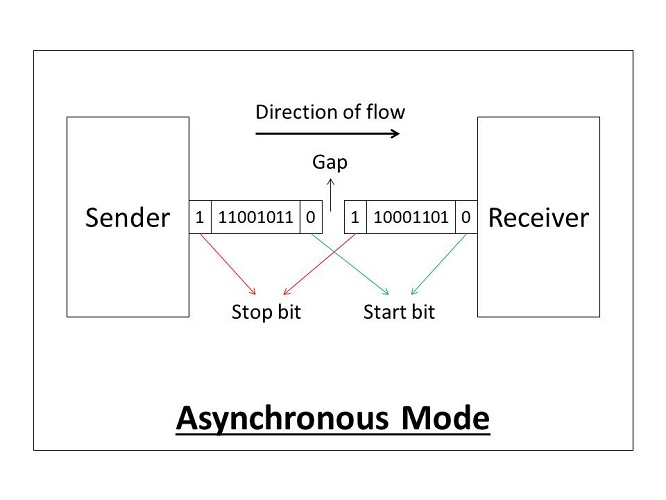
For Example, Data input from a keyboard to the computer.
Following are the advantages of using an Asynchronous transmission mode:
- It is a cheap and effective mode of transmission.
- Data transmission accuracy is high due to the presence of start and stop bits.
Following are the disadvantages of using an Asynchronous transmission mode:
- The data transmission can be slower due to the gaps present between different blocks of data.
According to the number of bits sent simultaneously in the network:
1. Serial
The Serial data transmission mode is a mode in which the data bits are sent serially one after the other at a time over the transmission channel.

It needs a single transmission line for communication. The data bits are received in synchronization with one another. So, there is a challenge of synchronizing the transmitter and receiver.
In serial data transmission, the system takes several clock cycles to transmit the data stream. In this mode, the data integrity is maintained, as it transmits the data bits in a specific order, one after the other.
This type of transmission mode is best suited for long-distance data transfer, or the amount of data being sent is relatively small.
For Example, Data transmission between two computers using serial ports.
Following are the advantages of using a serial transmission mode:
- It can be used for long-distance data transmission as it is reliable.
- The number of wires and complexity is less.
- It is cost-effective.
Following are the disadvantages of using a serial transmission mode:
- The Data transmission rate is slow due to a single transmission channel.
2. Parallel
The Parallel data transmission mode is a mode in which the data bits are sent parallelly at a time. In other words, there is a transmission of n-bits at the same time simultaneously.
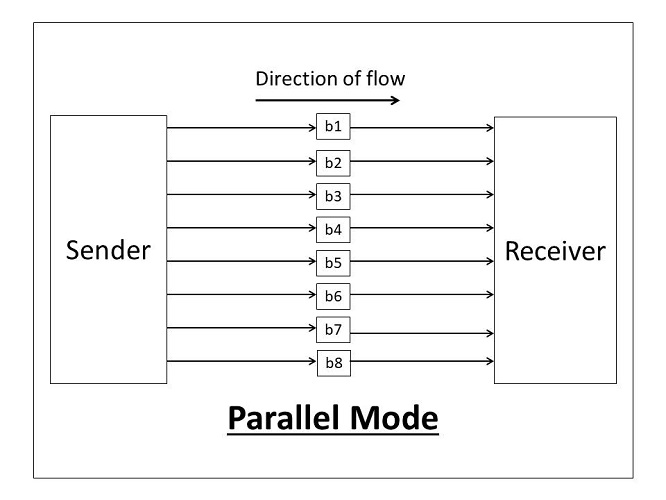
Multiple transmission lines are used in such modes of transmission. So, multiple data bytes can be transmitted in a single system clock. This mode of transmission is used when a large amount of data has to be sent in a shorter duration of time. It is mostly used for short-distance communication.
For n-bits, we need n-transmission lines. So, the complexity of the network increases but the transmission speed is high. If two or more transmission lines are too close to each other, then there may be a chance of interference in the data, degrading the signal quality.
For Example, Data transmission between computer and printer.
Following are the advantages of using a parallel transmission mode:
- It is easy to program or implement.
- Data transmission speed is high due to the n-transmission channel.
Following are the disadvantages of using a parallel transmission mode:
- It requires more transmission channels, and hence cost-ineffective.
- Interference in data bits, likewise in video conferencing.
Hence, after learning the various transmission modes, we can conclude that some points need to be considered when selecting a data transmission mode:
- Transmission Rate.
- The Distance that it covers.
- Cost and Ease of Installation.
- The resistance of environmental conditions.
This is all about the various transmission modes in a computer network. Hope you learned something new today. That's it for this blog.
Do share this blog with your friends to spread the knowledge. Visit our YouTube channel for more content. You can read more blogs from here .
Keep Learning :)
Team AfterAcademy!

